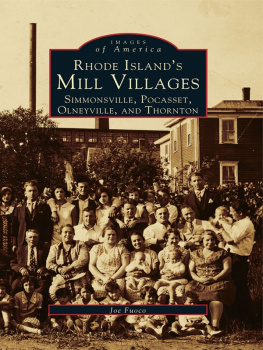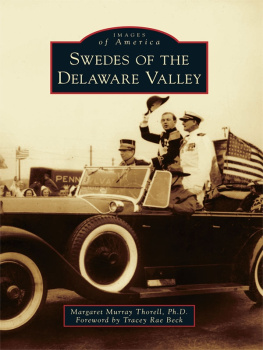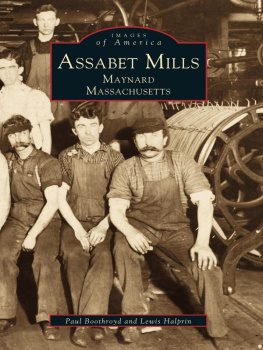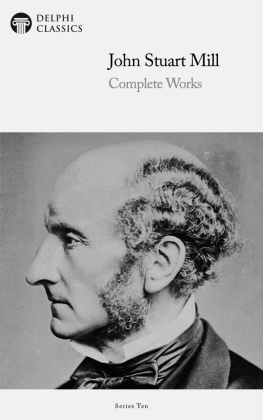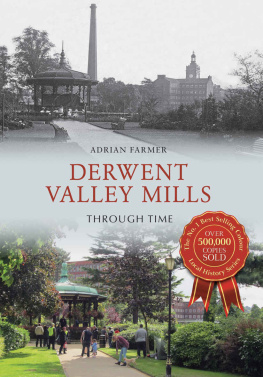A MILL SHOULD
BE BUILD THEREON
An Early History of the Todmorden Mills
ELEANOR DARKE

One of Torontos most visible landmarks is the towering 1825 brick chimney bearing the Todmorden Mills name.
Boris Novikoff, East York


Scene at the foot of Pottery Road Hill. Brick cottage dwelling was the foremans house and small barn was for the foremans use too. Henry Wilson is shown leading the horse, Thomas John is making hay and Mary Collins is at the water trough. The large barn and trough are in the paper mill yard. Painting by artist T. Mower 1838-1934 (known as the Grand Old Man of Canadian painting).
Courtesy Ann Guthrie, Author, Don Valley Legacy
A MILL SHOULD
BE BUILD THEREON
An Early History of the Todmorden Mills
A Mill Should be Build Thereon
Published by Natural History / Natural Heritage Inc.
P.O. Box 95, Station O
Toronto, Ontario M4A 2M8
Copyright 1995 The East York Historical Society.
The manuscript upon which this work is based is the property of the Borough of East York.
All rights reserved.
No portion of this book, with the exceptions of brief extracts for the purpose of literary review, may be reproduced in any form without the permission of the publishers.
Design: Derek Chung Tiam Fook
Printed and Bound in Canada by Hignell Printing Limited, Winnipeg, Manitoba
First Printing July 1995
Canadian Cataloguing in Publication Data
Eleanor Darke
A Mill Should be Build Thereon: An Early History of the Todmorden Mills, Governor Simcoe, 1794: industry and settlement on the Don
ISBN 0-920474-89-6
1. Todmorden Mills (Toronto, Ont.) History.
2. Toronto (Ont.) History. 3. Mills and mill-work Ontario Toronto History.
4. Toronto (Ont.) Industries History.
5. Land settlement Ontario Toronto History.
I. Title. II. Title: Industry and settlement on the Don.
FC3097.52.D37 1995 971.3541 C94-930435-2
FI059.5.T686D37 1995
The publisher greatly acknowledges the ongoing support and assistance of the Canada Council, the Ontario Arts Council, and the Government of Ontario through the Ministry of Culture, Tourism & Recreation.
The East York Historical Society gratefully acknowledges receipt of a local history publication grant from the Ontario Heritage Foundation.
Back cover colour separation entitled Old Paper Mill Sukimo, oil/board, not dated, courtesy of the East York Foundation.
CONTENTS
PREFACE
This book has been almost 200 years in the making! In 1795 Upper Canadas (now Ontarios) Lieutenant-Governor, John Graves Simcoe, wrote to Deputy Surveyor General, Christopher Robinson,... it is necessary that a mill should be build (sic) thereon. In directing the Skinners to build a saw-mill on the Don River near East Yorks present-day Todmorden Mills Museum, Simcoe began what became, fifty years later, an industrial complex of paper mill, grist mill, brewery, and starch factory, along with the unincorporated village of Todmorden.
Many modern-day people have been involved in getting the story of East Yorks early beginnings into print. First and foremost, of course, is the author and former curator of the Todmorden Mills Museum, Eleanor Darke, who revisited her manuscript, first written over ten years ago, and prepared it for publication. We are grateful to the Borough of East York for granting us the use of this original manuscript, which Eleanor wrote while she was an employee, as the basis for the book.
We are also grateful to researcher, Ian Wheal, who rechecked the references and assisted in the selection of illustrations. Sincere appreciation is also due to the staff at Todmorden Mills Heritage Museum and Arts Centre, particularly Curator/Administrator, Susan Hughes, who has kindly provided an epilogue, and Ann Symington, both of whom were most helpful to Eleanor and Ian.
Support funding for the project was graciously provided by the East York Foundation under Chairman Ed Barnett and the Ontario Heritage Foundation. Also, the Council of the Borough of East York and the East York Historical Society gave grants.
Hovering over all of this and making sure all the pieces came together at the right time was our genial publisher, Barry Penhale, whose abiding interest in East York and in heritage publishing were brought together in this endeavor with the happy result you now hold in your hands.
To all of you, our heartfelt thanks.
John S. Ridout, President
East York Historical Society
INTRODUCTION
The research for this book accumulated over many years. Between the tours and meetings, the correspondence and filing, the cataloguing and the phone calls that fill the days of a small museum Curator, I would carefully file each new scrap that appeared and wonder if I would ever be able to assemble it all into a readable history. The temptation to leave everything in files was strong. As long as the material stayed in the research stage, no one could judge my clumsy phrases or disagree with my assumptions. It is very easy to justify an endless collection of research. After all, there will always be more to find. However, with encouragement from John Rempel and others, I screwed up my courage. Here it is, warts and all. I sincerely hope that its readers can find in it some of the fascination I found in unravelling this history of Torontos earliest industrial village.
Although this book carries my name and I am responsible for any of its flaws, it is not solely my work. First and foremost, appreciation is due to Ian Wheal who did the research on which major portions of it are based. Ian worked as the historical researcher at the Todmorden Mills Museum for two summers under the Summer Canada grant programme of the Department of Manpower and Immigration and maintained his interest in the subject long after the funding ended. For a long time, little sheets of paper containing the most varied snippets of information and sources imaginable kept appearing on my desk marked from Ian. Ian has since gone on to do marvellous work for a number of other historical agencies in the Province and has acquired an excellent reputation in his field. I was very fortunate to have had his assistance with this project and am grateful to the Federal Government for the grants which permitted his hiring.
Thanks must also be expressed to all the volunteers, historical society members, descendants of local families, libraries and archivists who kept the flow of sources and information coming. They are too numerous to name individually but I hope that they will recognize their work in the finished product and realize the depth of my appreciation.
Eleanor Darke, Toronto
RESEARCHERS NOTES
What began as a Government of Canada summer research project on the history of the mill-site at Todmorden Mills Museum in May, 1977, quickly escalated by the fall of that year into a voluntary in-depth study based on primary sources in Canada and the United States. I was fortunate that work at East York Public Library (1978) along with another summer contract in 1979 allowed me to stay close to Todmorden Mills and gave me some time to travel to Niagara and Buffalo where major repositories of documents and records existed. The project ultimately consumed a four year period (1977-1981).



